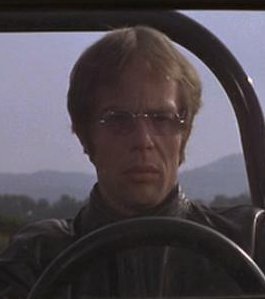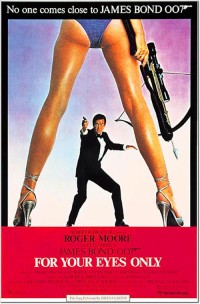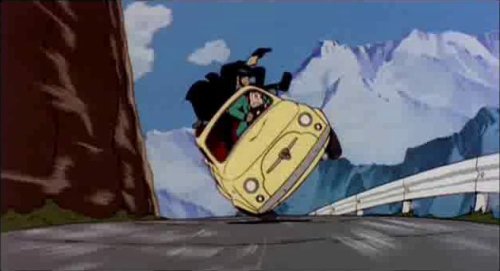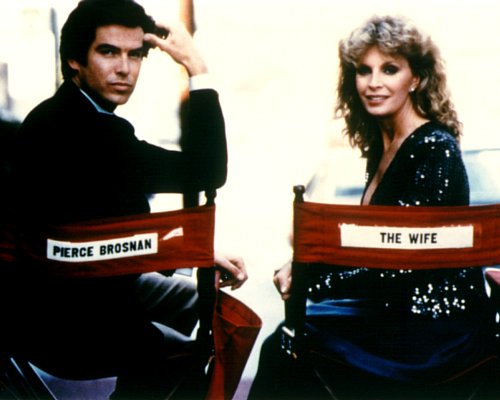After the outer space exploits of Moonraker
there was no choice but to bring Bond back down to earth.
- Variety (June 1981)
For Your Eyes Only
Film: 1981 (#12)
Book: 1960 (#8)
A disguised British surveillance boat is destroyed when a sea mine is pulled into its fishing nets (apparently this is a pure accident), but its ATAC device, a MacGuffin, is not destroyed. The Havelocks, undersea researchers who sometimes moonlight for the British government, find it, but they are murdered in front of their daughter Melina. Melina swears revenge and begins to track down the killers, through the treacherous triggerman Gonzales to his paymaster Locque. Bond is tracking down the same people in order to find the ATAC. After Melina shoots Gonzales, Bond has to resort to trying to find Locque; this search for information eventually connects him to Kristatos, who has contacts in the Greek underworld and is apparently sponsoring a young American ice skater. Kristatos says that Bond's problems emanate from a nasty gent named Columbo. Trying to get to Columbo, Bond ends up in bed with Columbo's sometime mistress, Lisl, who is killed the next morning by the villanous Locque. Bond is captured/rescued by Columbo's men. Columbo explains that Kristatos is the real villain, has been playing Bond, and Locque works for Kristatos. They raid Kristatos' warehouse and Bond eventually kills Locque. After that it is just a matter of finding the ATAC device with Melina and a helpful parrot, having it get stolen by Kristatos, and making a rock-climbing assault on Kristatos' haven, St. Cyril's, just in time to throw away the ATAC so no one can have it.
Book vs. Film
I let the synopsis above run long on purpose. If it seems like a big mess, it's because this film is actually two stories glued together, with a few extra features added in. Follow along with me now ....
The book For Your Eyes Only is a collection of five short stories. Four of the five were Fleming's adaptations of his own scripts for a Bond television series that never aired. Fleming assembled this book in lieu of a full-length manuscript at a time when he was apparently a little stuck for plots, following Goldfinger.
Two of the stories, "From a View To a Kill" and "Quantum of Solace," have never been used in the films except for their titles. We will discuss them at the appropriate films. The fifth, "The Hildebrand Rarity," will be discussed under Licence To Kill, as it contributes one of the major characters there. For Your Eyes Only is largely derived from the remaining two:In "For Your Eyes Only," war criminal von Hammerstein wants the Havelock property in Jamaica as a long-term refuge, so he sends Gonzales to either buy it or kill the Havelocks. They won't sell, and are killed. (Their deaths are even more wrenching in the book than in the film.) Bond is asked - completely unofficially - to go exact revenge by M, an old friend of the Havelocks. Bond goes to kill them, but encounters their daughter Melina, who is taking revenge on her own. Melina shoots von Hammerstein with her bow, Bond kills Gonzales, and they escape.
In "Risico," Bond is sent to infiltrate and stop a drug smuggling ring. His contact Kristatos tells him that the man he wants is Columbo. Bond gets to know Columbo's mistress, follows her, and is captured by Columbo, who reveals that ... well, you know the rest. The middle portion of the movie is a very close lift of this plot, including opium in the newsprint rolls and the tape-recorded conversation (in the book it's hidden in a chair, not a lamp), with the major difference that at the end of the warehouse raid in the book, Kristatos is killed.
Though one can quibble endlessly with why a spy boat would have a device on board which allows the control of missile-bearing subs, the film's addition of the ATAC MacGuffin is a reasonably clever way to tie two otherwise unrelated plots together. The script's other big insertions are cold-eyed killer Emile Leopold Locque, ice skater Bibi Dahl, and the St. Cyril's sequence. The keelhauling sequence was taken from the book version of Live and Let Die.
Himself
A grown-up. This is a sober, contemplative Bond, not much given to wisecracks but not disengaged either. Perhaps surprisingly, may be Moore's best Bond. Ethical, clearly upset by the deaths of people in this film whom he likes - upset enough to commit one of the most cold-blooded murders in any of the films. (But that's okay, because it couldn't happen to someone who deserved it more.)
This is the first Moore film to consciously play Bond as an older gent, who has to choose somewhat different tactics. There's yet another lengthy snow-sports sequence in this film, and it bears a great deal of resemblance to OHMSS, but it doesn't feel like a retread, mostly because Bond's tactics are different here; he can't outrace or outperform the younger men (especially the biathlete Kriegler), so he has to resort to sneakiness and concealment.
Alas, everything must have a counterpoint, and this is the rare Moore film where I consider Bond to be a fashion victim. Of course, the things he wears in this film don't look attractive on anyone else either, but that's no excuse.
The Women
The Bibi business is so obviously grafted onto the movie that some commentators have wondered if it isn't the film's attempt to make a subtle point. The idea of subtext in a Bond film seems inherently ludicrous, but on repeat viewings I have come to agree: This may be partially a film about getting old. Bibi may be there entirely so Bond can reject her.
Moonraker is the first time I really noticed that Roger Moore was too old for the part, at least as played there. (It mostly hits me in the pre-credit sequence, where the stewardess he's seducing could be his daughter.) Here, for the first and perhaps the only time in the films, this aging aspect is made explicit. Moore comes into close contact with three women, and behaves very differently toward all three of them. He is carefully neutral to Melina, only ending up in bed with her once she has given a clear signal it's okay; unusually cautious, in other words, for Bond. Bibi he rejects entirely and thoroughly throughout, as is fitting ("Get dressed and I'll buy you an ice-cream" is exactly the response she deserves to her seduction attempt). But the "Countess" Lisl he encounters enthusiastically, as a peer. Their intimate scenes are definitely portrayed as being the intimacy of older people, who have been around the block a time or two, and this is how it should be.
Interestingly, the actual ages of the three women are not that far apart. (Cassandra Harris was born in 1952, Carole Bouquet in 1957, and Lynn-Holly Johnson in 1958.) But they are played as being of dramatically different ages, and that's what's important. Moore, for the record, was born in 1927, which made him 54 at the time of this film and thirty years older than his leading lady of record. No wonder he approaches her carefully!
Backstory
Moore refused to commit to a contract, so for the rest of his films there would be a dance where Broccoli tried to scare him by screen-testing other actors and Moore would try to wait until he didn't think he could get Broccoli to put any more money on the table. Moore wasn't just being difficult/greedy; he'd reached the point where he had definite misgivings about the part (he had back problems and other health issues, and the shoots were hell), so he felt justified in demanding huge sums to be put through the wringer again. He was clearly pretty tired of Bond; he had spoofed himself twice earlier that year - once on "The Muppet Show" and once in The Cannonball Run, where he plays a racer who has a delusion that he's Roger Moore. (See also ffolkes from 1979, where he delights in playing a character as unlike Bond as it is possible to be.)
Meanwhile, changes were happening on the back end. Broccoli stepson Michael G. Wilson, whom you've seen lurking around these productions in various capacities for some years if you've been reading these pages carefully, was officially given an executive producer credit on Moonraker. On this one he is also given a screenwriter credit along with Richard Maibaum. I'll comment on Wilson's contribution to the mythology below. We are far from done with him.

Wilson makes a lot of cameos in these films from here on. In this one he's the Greek priest officiating a wedding in the first St. Cyril's. If you'd like to keep an eye out, there he is above.
John Glen, who had been laboring in the Bond trenches off and on for over a decade at this point, was finally given the director's seat. He would hold it for five films - the record to date. Glen, unfortunately, is probably my choice for the worst of the Bond directors. He's not bad with action sequences, but he seems to have no idea what to do with the rest of the film. He's fond of making people fall from great heights, and he likes to include a shot where a startled bird flies away suddenly. God save us from directors with trademarks. Still, those who like to look for such things now know what to look for. (Hint: In this film, it happens during the St. Cyril's ascent.)
Peter Lamont, another one who'd been kicking around in Bond credits for quite a while, was brought on as production designer. He's not Ken Adam, but for this film, he doesn't need to be. (Incidentally, Adam was off doing Pennies From Heaven.) Lamont's finest hour was probably the Oscar he won for set-dressing James Cameron's Titanic in 1997. Alan Hume, new cinematographer, also has a number of interesting career notes, including A Fish Called Wanda and Return of the Jedi.
Decidedly not a Bond regular is composer Bill Conti. I have innate biases against the man which are not germane here, but I'm pretty sure I would hate this horrible, intrusive score even if I didn't know he wrote it. The low point is the second half of the winter-sports sequence where it comes close to derailing the whole film. The silver lining is that, by Octopussy, John Barry will feel welcome again. (He was still dodging UK taxes at the time.)
The producers did not care to immediately recast Bernard Lee, out of respect. (He was reportedly still on the docket for this one until it became clear his health was too poor to make it through the briefing scene.) Instead, James Villiers was hurriedly called in as the Chief of Staff; he and Geoffrey Keen as the Minister of Defense cover the duties between them, with some help from Q. Villiers is a horrible Bill Tanner - this is a character who is supposed to be Bond's best friend in the service, you understand - and reportedly thought he was being considered as a permanent M and was surprised when he was not cast again. (They considered him too young for the part.) Tanner will get proper handling in the Brosnan era.
The Briefing
This is a much better Bond film than you think it is.
It represents a deliberate move by the crew away from the empty
spectacle of Moonraker. Wilson and others have admitted this
explicitly, that they felt a need to bring Bond back down to earth and
into the real world again. Unfortunately, audiences didn't seem to buy
into this very well, particularly in America where they have
no brainswhere they may not have cared for the slower pace of
this film. It wasn't a flop, but it wasn't a blockbuster either.
This has led people (usually people who have never seen the film) to draw the wrong conclusions about it, so let me set you straight: This is the Bond sleeper. If you haven't seen it, and you don't mind a Bond film which is deliberate (even cerebral, by Bond standards), you should have a look at this one.
I'm not saying the film is perfect. Carole Bouquet cannot act, although she isn't unpleasant to watch; her attempts to demonstrate her anguish over the horrible murders of her parents are not even pronounced enough to be laughably bad. Mostly she just looks confused the whole time. Lynn-Holly Johnson is as annoying as all get-out, but she's supposed to be, and she's doing the job she was paid for. (Cassandra Harris is flawless.)
The main villain is almost completely uninteresting, made more so by a henchman who totally eclipses him. Julian Glover, perennial villain, is capable of better work than he gives here as Kristatos. He was quoted as saying "As an actor, I have to be fairly good as Kristatos because he has no noticeable eccentricities." Good plan, Julian; bad execution. At least Chaim Topol brings gusto to his role, if not actual quality. By the by, this is an unusually svelte Topol we see here; it strikes me every time I see it. I think I'm always expecting Tevye.
Michael Gothard, as Locque, commits some of the most deeply felt evils in any Bond film outside of the last three minutes of OHMSS. Certainly Bond feels the impact of his work, and when Bond decides to murder him, it comes off not as an abominable act but a deeply deserved revenge. Moore reportedly had doubts about that scene, but he shouldn't have. Locque's effectiveness is even more striking when you realize the character has no lines!

The film has one of the best car sequences ever in a Bond film, plotted by the masterminds at the Remy Julienne stunt team (they also did the car work in the original Italian Job, among other things). It is doubly good because we start off with a fake-out - Bond's ugly-ass Lotus is suddenly blown up (hell of an antitheft device, that) and we end up in Melina's indestructable 2CV! Name me another film which has a car chase using a 2CV. I dare you.
The only seriously slack moments in this film are (unsurprisingly to anyone who has read my ranting so far) the underwater ones. The drive temporarily goes out of the film when Locque is killed anyway, and to then deal with the underwater exploration and the keelhauling nearly stops it dead. (A note about the latter is below). Still, this is easily remedied. Just do some judicious fast-forwarding between Bond killing Locque and that damned parrot saying "ATAC to St. Cyril's" and you'll be fine.
Here we see the Cold War reenter the Bond universe. This is apparently largely Michael G. Wilson's doing, and I can see why he did it - he wanted to go back to actual realities. Unfortunately this immediately reintroduces the "why would Britain even be involved in this?" question, but here it's not too distracting. Anyway, this isn't the same Cold War as in the Connery days. From here on, if there are Russian villains, they will be portrayed as rogue elements, loose cannons, not approved by a Russian government that actually just wants to keep the peace, whatever they may say in the news. "That's detente, comrade."
Obscura
The keelhauling sequence was one that both Saltzman and Broccoli were (inexplicably) very enthusiastic about. They'd wanted it in Live and Let Die, but couldn't fit it in, and had been trying to find a place for it since then. "It's a scene no one really wanted to shoot, except for Cubby [Broccoli]," John Glen said in a 1981 interview, because of the difficulties involved. He added that it was the most expensive of any of the Bahamas shooting, needing four or five camera crews.
The St. Cyril's sequences were filmed at a monastery in Greece. Neighboring monks didn't like these sinful influences nearby and did everything they could to protest the filming - including, one report has it, hanging laundry out their windows in hopes it would ruin the shots.
Much later, another sin scandal broke out when several markets objected to the original poster for the film (which has Bond framed below a pair of woman's legs). Apparently the legs were a little too bare for some; at least one newspaper drew on a pair of shorts before running the ads, including my local Boston Globe.

The Identograph sequence, with Bond and Q working into the night together, is oddly refreshing - perhaps it is because it shows that the two characters can work well together despite the bickering.
Two things we will not speak of: Sheena Easton, whom I don't even want to hear, much less see (in the title sequence), and the 10 Downing St. sequence that not only closes the film on a low note, but dates it badly. (Moore hated it too. He also hated the damned parrot.)
Bond being sent to track down the payoff chain instead of going back to the site of the ATAC disappearance strikes me as a strange way to pursue the matter. One thing that's initially disorienting about the film is how he suddenly turns up at Gonzales' place - whose place is it? Why is he sneaking up on it? Why is he here?
Speaking of Gonzales' pool party, much fuss was made at the time about how one of the women in that sequence, Tula, later turned out to be a transsexual. I read an interview recently with a major transgender activist who cited this as an early influence on her. Not much of an influence, to my mind; more of a mountain from a molehill (who really notices the eye-candy women with no speaking parts scattered through a Bond film anyway)?
The chase sequence in the Citroen seems to me to have more than a few correspondences to the beginning of the animated film, The Castle of Cagliostro, directed by Hayao Miyazaki in 1979.

It's probably just my imagination, but it's also possible that the Remy Julienne team had seen the other film ....
The underappreciated Charles Dance (well, he's gotten a lot more appreciated these days, but some of us adored him even back when), can be seen briefly in his film debut (!) as a heavy in the ski-jump sequence.
I have a rumor here that the underwater closeups of Bouquet and Moore were faked - filmed in a dry studio, probably through a water panel, with a fan making their hair move, with air bubbles etc added later. I can't find anything confirming this but apparently, the rumor goes, Bouquet had a sinus condition that prevented her from actually being underwater for any length of time.
A stuntman, Paolo Rigon (one of my books has Gigon; IMDb has Rigoni), was trapped under his bobsled and killed during the filming of that scene - the first fatality on a Bond set. Cassandra Harris' stunt double was reportedly injured during the scene where Locque runs her down.
The pre-credit sequence, with Bond and a man who is never named as Blofeld, is of course partially a matter of giving the finger to Kevin McClory, but also initially was meant to serve another purpose. As noted above, while Moore was playing show-me-the-money with Broccoli, EON seriously began to wonder whether they'd need to recast this one. The opening sequence, with Tracy's grave and so on, was deliberately written as a continuity bridge to earlier Bonds. When Moore signed back on, they left it in as a joke.
The general assumption seems to be that the inexplicable "I'll buy you a delicatessen in stainless steel" is a spur-of-the-moment line that someone thought was funny enough to keep; it's not in the script. Not-Blofeld, by the by, is played in body by John Hollis, whom fans of British '60s TV know well on sight but everyone else has probably only ever seen as Lobot in The Empire Strikes Back. One source gives his voice as recidivist dubber Robert Rietty; another says it is Peter Marrinker.
Cassandra Harris was romantically entwined with one Pierce Brosnan, and married him during the filming of this movie, in December 1980. She appears to have introduced Brosnan to Broccoli during this film, and this may have been significant to Broccoli wanting to cast Brosnan in 1986 ... but then, on the other hand, some say Brosnan would have been in serious consideration anyway. You decide.

Harris would begin to suffer seriously from cancer within a year or so of this film, making this her final film role; Brosnan's low profile during the late Eighties is largely due to his caring for her and their children during her long illness. She died in December 1991.
« Heavy Bondage
« Opening Titles
All material on this site is under copyright by its author, except for quotations and images used for purposes of commentary (and which belong to their respective owners/authors). All rights reserved. Do not reproduce without express permission. Correspondence goes to projectionist at shrunkencinema dot com. No guarantees. Contents may settle during shipping; this product is sold by weight, not by volume.
These pages and their author have absolutely no affiliation whatsoever with Ian Fleming (Glidrose) Publications, EON Productions, Danjaq LLC, MGM/UA or any other creators of the James Bond novels or films.